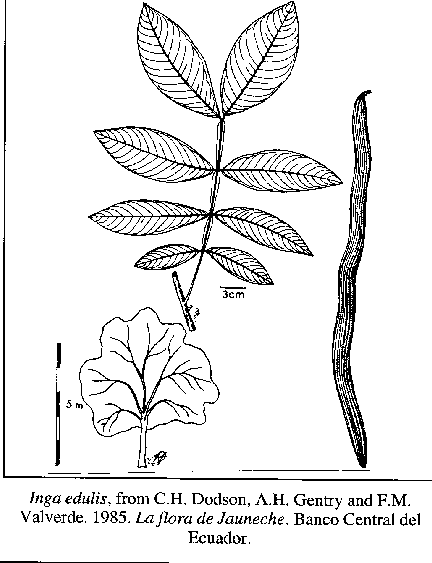Inga edulis: a tree for acid soils in the humid tropics

NFTA 93-04, September 1993
A quick guide to nitrogen fixing trees from around the world
Inga is a large genus of leguminous trees native to the American humid tropics. Inga edulis, the best known of the Inga species, is popular with agroforesters for its rapid growth, tolerance of acid soils and high production of leafy biomass to control weeds and erosion.

Botany
Inga edulis Mart. is one of about 250 species of Inga of the Mimosoideae subfamily of the Leguminosae. It reaches a height of 30 m and a stem diameter (dbh) of 60 cm, and usually branches from below 3 m. The branches form a broad, flat, moderately dense canopy. The bark is pale grey and smooth, with pale elongated lenticels. The young twigs are angular in cross-section and covered in fine short brown hair.
The leaves are once pinnate, up to 24 cm long, with 4 to 6 pairs of opposite leaflets. The terminal pair of leaflets is larger than the basal pair and can be up to 18 cm long and 11 cm wide. Between each leaflet there is a nectary gland on the leaf rhachis; in I. edulis these are large (2 to 3 mm) and squashed transversely, an important character for identifying the species.
The leaflets and rhachis are covered in dense, short, rough brown hair. The seedlings have a characteristic grayish sheen on the upper leaf surface.
The inflorescences are dense axillary spikes of flowers, each consisting of a calyx tube with 5 lobes (4 to 9 mm long), a corolla tube with 5 lobes (13 to 25 mm long), and a large number of white stamens up to 4.5 cm long, united in a tube in the lower half. In humid climates I. edulis may flower throughout the year, but in regions with a short dry season it is most likely to flower at the beginning of the wet season. The inflorescences may not have many flowers open at the same time, but they are usually conspicuous.
The fruits are ribbed, cylindrical pods, straight or often spirally twisted, up to l m long (occasionally even longer), and 3 to 5 cm in diameter. They contain fleshy green seeds (3 cm long) in a sweet, white, cottony pulp. They are produced during the wet season, and monkeys and birds eat the sweet pulp and scatter the soft seeds (Castro and King, 1950). These are recalcitrant and sometimes begin to germinate in the pod, often within a few days of reaching the ground where they need humidity to survive.
Distribution and ecology
The native range of Inga edulis is in Amazonian Brazil, Bolivia, Peru, Ecuador and Colombia. The species has also been introduced across most of tropical South America, Panama and Costa Rica. It grows in hot, humid climates between 26°S and 10°N, and up to 1600 m elevation. It is most widespread in areas without a dry season (Andean South America, western Brazil) or with a dry season of three to four months and minimum annual rainfall of around 1200 mm. It can tolerate short droughts, although in its natural range some rain falls every month.
Inga edulis is particularly tolerant of acid soils (Smythe, 1993; M. Hands, Department of Geography, Cambridge University, personal communication; Salazar and Palm, 1991), outgrowing many other leguminous trees in trials under such conditions. It is a forest gap regenerator: although seedlings often establish themselves in the shade of other trees, it needs light to grow and flower. In the forest it becomes a canopy tree, but it is also common in secondary forest.
Uses
Shade and litter. Inga edulis has been used as a shade tree for perennial crops–mainly coffee and cacao–since the beginning of the nineteenth century. Many farmers value it as much for soil protection as for shade. The leaf litter protects the soil surface and roots of other plants, helps retain nutrients in the topsoil, and (most importantly for farmers in the humid tropics) controls weeds.
Improved fallow. In Amazonian Peru, Szott and Meléndez (1991) grew crops on land cleared and burnt after seven different fallow treatments. Land where Inga edulis had been planted gave the highest crop yields–34% higher than crops following natural forest fallow.
Alley cropping. In species trials in Costa Rica, Peru and Brazil, I.edulis was outstanding in terms of growth. Coppice regrowth was also good after pruning. In four out of five trials, crop yields were higher under alley cropping with I. edulis than in control plots (Smythe, 1993; Fernandes et al., 1991; Salazar et al., 1991; Salazar and Palm, 1991; M. Hands, personal communication). In two of these trials, crops performed better with I.edulis than with other species (Salazar and Palm, 1991; M. Hands, personal communication).
The litter is high in nitrogen, lignins and polyphenols. It is slow to decompose, but provides a long-term build up of organic nitrogen (Palm and Sanchez, 1990) and effective weed control. Weed biomass decreased considerably in all agroforestry trials with I. edulis, much more than with other leguminous species (Salazar and Palm, 1991). On cultivated slopes, I. edulis mulch reduced soil erosion to levels almost equal to those under secondary forest (Alegre and Fernandes, 1991). Existing trials are still too new to ascertain whether I. edulis can maintain or improve soil fertility on acid sites in the long term, but results so far are promising.
Other uses. The large fruit is popular throughout the region where I. edulis is distributed. Fruits are sold in local markets in Bolivia, Peru, Ecuador, Brazil and Costa Rica. The branches are a popular source of fuelwood, with a high calorific content and little smoke, but the trees are not cultivated specifically for fuelwood.
Silviculture
Propagation. Inga edulis seed can only be stored up to two weeks. Best results have been achieved by removing the pulp and storing the seed in impermeable bags. Normally, only one seed should be sown in a plastic bag, no more than 2 cm below the soil surface. Semi-shade should be provided if possible. The seeds germinate readily (95 to 100% germination rate) within 2 to 3 days. Seedlings are normally kept for two months in the nursery. They should be watered regularly and the shade should be removed one month before transplanting.
Establishment. Farmers sometimes sow I. edulis seed directly in the field. This must be done during a season of regular rainfall to avoid seed desiccation. Direct seeding has not yet proven to be a reliable method for establishing a trial. Bare-rooted seedlings can be transplanted successfully from the nursery (Fernandes et al., 1991). Inga edulis has not been reproduced by cuttings.
Management and symbiosis. An area of 1 m diameter should be kept clear around the trees during the first six months as they become established. Inga edulis grows back well after pruning, but not if cut too low (below 0.75 m). It responds better if pruning height is varied and a few branches are left uncut (Salazar et al., 1991). The cut should be made carefully, at least 3 cm above a node from which the shoots can grow again (M. Hands, personal communication).
Fernandes and others (1991) observed Rhizobium nodules on the roots of I. edulis, both in the field and in the nursery. They also showed that vesicular-arbuscular (VA) mycorrhizal infection
occurs in acid tropical soils and that nodulation rates increase when mycorrhizae have infected the root. In their trial, plant biomass correlated positively with length of root infection by VA mycorrhizae.
Limitations. Inga edulis pods are heavy and bulky to transport. This, combined with short seed viability, means that I. edulis seed must normally be collected near the planting site. Decomposing slowly, the leaves do not provide fast-cycling green manure. In Ecuador, Inga edulis is particularly susceptible to infestation with mistletoe.
Related species
In Central America, I. edulis is replaced by the closely related I. oerstediana Benth., a popular species for coffee shade from sea level to elevations of 2000 m. The flowers are smaller than those of I. edulis and the fruits are much shorter. In ongoing trials in Honduras and Costa Rica, I. oerstediana has shown fast growth and abundant production of leafy biomass. Another promising species from the same section of the genus is the Amazonian I. ingoides (Rich.) Willd., which has grown well for four years on a periodically flooded site in lowland Bolivia.
Research needs
Inga edulis has been introduced throughout the neotropics, but seed is usually collected from a few trees already established in plantations and transported over very short distances. Population studies in the species’s native range could help identif diversity in growth rate, fruit size, soil tolerance and litter-decomposition rates. Methods to prolong seed viability would also improve the usefulness of this species.
References
Alegre, J.C. and Fernandes, E.C.M. 1991. Runoff and erosion losses under forest low-input and alley-cropping on slopes: Y-433B. In TropSoils technical report 1988-89. Raleigh, NC (USA): North Carolina State University, pp. 227-28.
Castro, Y.G.P. and Krug, P. 1950. Experiments on germination and storage of seeds of Inga edulis, a species used in shading coffee trees. [In Portuguese.] Sao Paulo (Brazil): Office of the Secretary of State for Agriculture, Forestry Service.
Fernandes, E.C.M., Davey, C.B. and Sánchez, J.A. 1991. Alley-cropping on an Ultisol in the Peruvian Amazon: mulch, fertilizer and hedgerow root-pruning effects: Y-433A. In
TropSoils technical report 1988-89. Raleigh, NC (USA): North Carolina State University, pp. 223-26.
Palm, C.A. and Sánchez, P.A. 1990. Decomposition and nutrient release patterns of the leaves of three tropical legumes. Biotropica. 22(4):330-38.
Salazar, A.A. and Palm, C.A. 1991. Alley-cropping on Ultisols: Y-425. In TropSoils technical report 1988-89. Raleigh, NC (USA): North Carolina State University, pp. 221-22.
Salazar, A.A., Palm, C.A. and Szott, L.T. 1991. Alley-cropping on alluvial soils: Y-417. In TropSoils technical report 1988-89. Raleigh, NC (USA): North Carolina State University, pp. 218-20.
Smythe, S. 1993. The role of trees in tropical agroforestry. Ph.D. thesis. Cambridge (UK): Cambridge University, Department of Plant Sciences, 215 pp.
Szott, L.T. and Meléndez, G. 1991. Crop yields, soil nitrogen mineralization, and soil chemical properties following 4.5 years of managed leguminous fallows. In TropSoils technical report
1988-89. Raleigh, NC (USA): North Carolina State University, pp. 234-36.
This issue was prepared by Anna Lawrence, Royal Botanic Gardens, Kew Richmond, Surrey TW9 3AB, UK.
A publication of the Forest, Farm, and Community Tree Network (FACT Net)
